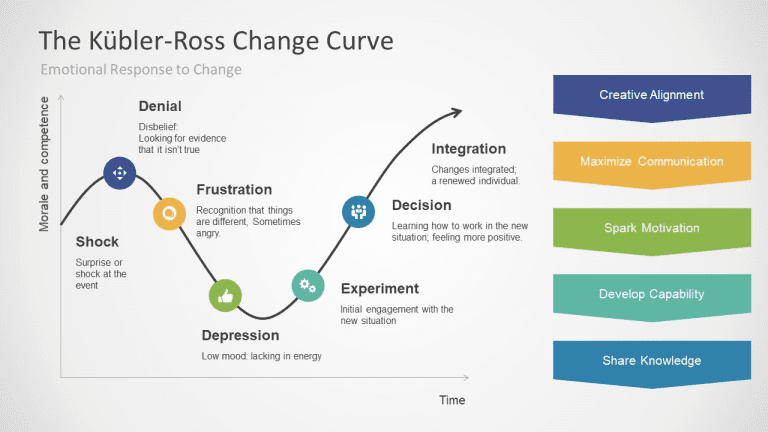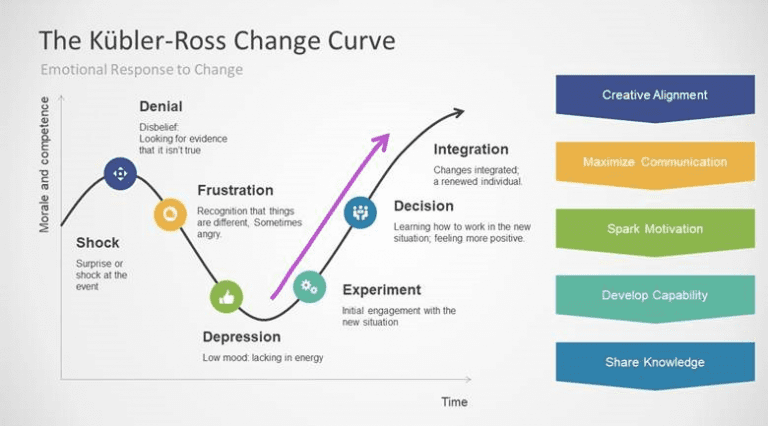Jop Vening
Read all my blogsEverybody experiences an optimization differently. How to get the best out of it?
As a business process owner or manager you might be very excited about the (project)board approval to implement a certain optimization in the team or organization’s way of working. This improvement step can be a change in the current team, way of working or it-system/landscape, which is framed/limited, more extensive, a combination of these two or a plural (like a program). The excitement you have about the decision, the GO to implement the optimization, is maybe not the excitement you feel in the response(s) of your colleague(s) in the team which must give valuable input, accept and adopt the optimization.
To get an understanding why this is, the change curve of Elisabeth Kübler-Ross gives an answer.

It’s a simplistic view in how people experience and react psychologically to a message where a change of themselves (e.g. way of working, system input, communication) is needed.
In short: First the message creates a shock by the receiver, because something needs to be changed which already “worked” before. This automatically leads into a level of denial or disbelieve which decreases the morale. When the receiver identifies a win, preferrably on personal level, the decreasing morale and competence curve with frustration and depression will be turned and kept short. Engagement of the to-be situation from the individual is necessary for a clear decision and creates a proactive/constructive attitude with acceptance and adoption of the change in the end. For every message, a human goes basically through this process. Once, multiple times, short, long, it exists in all variants en degrees. See here for an in-depth explanation of the curve or usage in an organizational change.
To get back to the less excited expression(s) you got, it has all to do with: Where is somebody in the curve? Big chance you’re much further than others because you were involved in the decision making process. This guided you through some different stages of the change curve and “presented” you a future insight of the proposed optimization with personal win*.
* A personal win could also be creating goodwill to your manager or organisation which results in complements, good image or respect.
For a partner in Customer Experience implementation & optimization, our perspective, we often experience some lack of energy and excitement in the organisation to work on the optimization as well. To define, realize, deliver and finally adopt it. Question becomes: How can we all move forward to get the best out of it?
Most of the times the GO is the starting point for a project to get the improvement step(s) done. The business process optimization often triggers a system implementation or enhancement. We get involved to enable, adopt and support these process changes and system implementations. To get this job done “easily” we provide a delivery approach named Acorel Activate. In 6 clear project steps (phases) the project will be structured and guided to define, realize and deliver the new to-be process(es) in the organisation way of working. In first two steps, a team is created. Key in this team are the business process owners, people with good knowledge of the daily operations and organisation processes. They, together with our Customer Experience experts and other stakeholders, must give the energy to get the best out of the defined to-be process (empowered with systems and tools) and are responsible to get the optimization adopted in the organisation.

Even though the Acorel Activate is a quite solid approach based on proven project management methods, such as Agile/Scrum, Activate and Prince2, it is not the main answer. Like all delivery approaches and methods, it’s all based to work to the new optimized situation (define, realize, deliver and adopt). It works in the most effective way if people are out of the depression stage, open to experiment and want to think about the new future. This is key for each person in the team or who is involved. Basically, main question still exists: Where is each person, who is involved in the optimization, in the Kübler-Ross Change Curve?

Our Customer Experience consultants have knowledge and are experienced in change management. While executing the Acorel Activate delivery approach they get a picture if the involved person is in the right mood and energy to get the best out of the optimization. If not, thew will address this on the right level, so organizational management can take responsibility and bring each person in the right mood (in the direction of the purple arrow).
To get people open and excited for the optimization, the “Frustration” & “Depression” stages must be passed with “Maximized Communication” and “Sparking Motivation”. This communication has nothing (or very less) to do with a clear explanation of the proposed to-be situation or the delivery method which will be used to get the job done. This communication must be clear and transparent on the required optimization and on the level of feeling and emotion. Tips about how to coach people through this change curve can be found here.
By working together like this:
- A clear approval from the (project) board with some excitement as starting point to implement an optimization,
- A team with Business process owners, Customer Experience Consultants and other stakeholders to move the change forward into adoption, and
- Organizational management who understands their role to get each person in the upwards part of the change curve,
Everybody gets the right energy, becomes excited about the optimization and want to get the best for the future!
Are you more excited in how you can drive optimizations to adoption? Acorel is providing a serie about User Adoption this summer. In 4 Videos (&Podcasts) usefull knowledge will be shared by us.
For any further remarks or questions, you can drop a message below.



